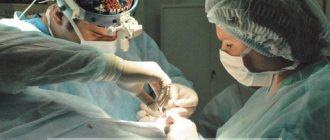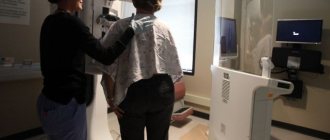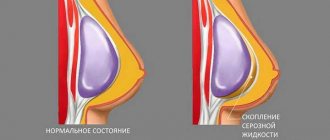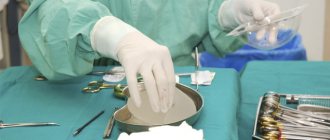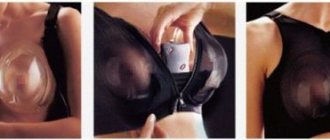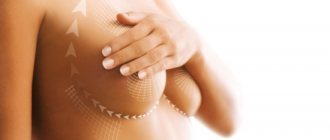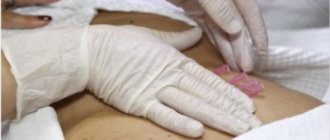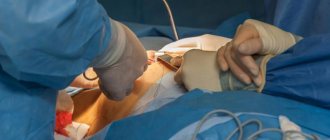Our expert - plastic surgeon, oncologist surgeon, active member of many European medical societies and RUSSCO (Russian Society of Clinical Oncology) Mikhail Ovchinnikov.
Breast cancer is the most common malignant tumor in women. Despite the fact that oncological surgeons are sometimes able to perform breast-conserving operations, many patients have to sacrifice their breasts in order to save their lives. Fortunately, the removed breast (or both) can be restored.
You won, what's next?
Rehabilitation doctor, candidate of medical sciences, head of the rehabilitation department Olga Obukhova and rehabilitation doctor Marina Khulamkhanova State Budgetary Institution "National Medical Research Center of Oncology named after. N.N. Blokhin" of the Ministry of Health of the Russian Federation: - The treatment plan for each patient is determined at a consultation with the participation of a surgeon, chemotherapist and radiologist.
Treatment of breast cancer includes local treatment (surgery, radiation therapy) and systemic treatment (chemotherapy, hormone therapy, targeted therapy). Surgery to remove the breast is called a mastectomy. This is usually only part of the comprehensive treatment prescribed to women diagnosed with breast cancer. Its goal is to prevent the spread of the cancer process. Breast removal in women is achieved by completely removing the tissue of the gland itself, the surrounding subcutaneous fat and lymph nodes.
The operation is traumatic for the body, but overall health is restored quite quickly. By the evening after the operation (by agreement with the attending physician), you can sit up in bed and get up on the second day. If your health allows, you can carefully move around the room and go to the toilet on your own. On the 3rd–4th day after the operation, the state of health becomes normal. The length of hospitalization after surgery averages 10–21 days.
Beginning rehabilitation after mastectomy
Before discharge from the hospital, patients are given recommendations for further treatment and follow-up. Rehabilitation begins immediately after the operation and includes physical therapy, massage, physiotherapy of various volumes, psychotherapy, and, later, after removal of the stitches, wearing a properly selected prosthesis and underwear. Surgical treatment of a particular volume (organ-preserving or complete removal of the mammary gland) often leads to postoperative complications and functional disorders - a decrease in the range of movements in the upper limb on the side of the operation, swelling (lymphostasis) of the upper limb and chest, pain, poor posture, weakness , soft tissue dysfunction, pain, fatigue.
Carrying out full rehabilitation in such patients helps accelerate the healing process of the postoperative wound; reducing swelling in the surgical area; improving lymph outflow; restoration of conductivity in nerve structures affected by trauma or compression; reduction of pain syndrome; prevention of development and elimination of already formed stiffness and contracture. To achieve this, a special massage is performed, a specially developed complex of physical therapy is prescribed, and physiotherapy procedures are permitted for such patients.
How can you restore lost breasts?
Breast reconstruction can be performed using the following methods:
- Using silicone implants
- Using your own fabrics
- Combination of own tissues and silicone implants
There is no “best” way of breast reconstruction. The method is selected together with the surgeon, taking into account the size of the mammary gland, the disease, the treatment performed or planned, as well as the constitution, general health and the presence of bad habits.
Your surgeon should explain to you the pros and cons of each method as it applies to your situation and give you his or her opinion regarding the choice of reconstruction method.
Currently, the incidence of complications of reconstructive interventions has been reduced to a minimum, but this is true for patients in whom the correct choice of reconstruction technique was made.
The risk of reconstruction complications may also be high in patients who are overweight, have chronic diseases such as diabetes, systemic connective tissue diseases, and cardiovascular diseases. A bad habit such as smoking can cause serious complications, so you should think about getting rid of it before reconstruction.
Most reconstructive techniques include several stages. The first stage, regardless of the method, always requires hospitalization and general anesthesia. The final stages, such as nipple and areola reconstruction or lipofilling, can be performed on an outpatient basis.
Compression sleeve after mastectomy
Compression therapy is the basis for the treatment and prevention of lymphedema (“lymph stagnation”). Only a rehabilitation specialist can help you choose the right model of compression hosiery. Compression underwear will bring relief to a woman in a short time: it will relieve swelling, reduce pain, thereby increasing the quality of life. When swimming in the pool and doing therapeutic exercises, wearing a compression sleeve is mandatory. But there are some contraindications to compression therapy: erysipelas, severe pain.
Exoprostheses and special underwear after mastectomy
Exoprostheses are artificial overlays made of soft materials. They imitate the shape and size of the patient's real breasts. Exoprostheses are selected individually for each woman and are worn continuously after the permission of the attending physician. A correctly selected exoprosthesis will give a woman confidence, and will also become a therapeutic and prophylactic means of rapid post-operative adaptation.
The exoprosthesis compensates for weight imbalance, preventing secondary body deformations such as curvature of the spine, drooping shoulders, and poor posture. It is also worth noting the importance of special underwear that will secure the exoprosthesis. Special bras are worn together with exoprostheses. They provide safety and comfort when wearing exoprostheses.
The straps of special bras are padded, widened in the shoulder area, do not cut into the skin, and reduce pressure on the shoulders, preventing lymphedema. The underwear should fit tightly so that the prosthesis does not change position when moving and bending.
Secondary breast reconstruction (nipple and areola plastic surgery, correction)
After the patient has fully recovered from the previous operation and has completed the entire course of adjuvant therapy, nipple and areola plastic surgery becomes a kind of final stage of breast reconstruction. During a mastectomy, the areola may be severely damaged or completely removed.
In this case, surgery to create a nipple and areola is required. The intervention is performed under general anesthesia, during which surgeons create the additional required volume and apply medical tattooing.
Also, a special gel or fat is sometimes injected into the nipple for additional volume. Those areolas that were transplanted from a skin fold in the groin area acquire the greatest aesthetics.
Time for a silicone prosthesis
Of course, patients are concerned about the question of when they will be able to purchase silicone prostheses. Wearing them is not recommended in the first days after surgery. Silicone prostheses are contraindicated for women undergoing radiation and chemotherapy. During this period, the sensitivity of scars and skin around the stitches increases, and sweating increases. Silicone pads do not absorb moisture well, so they can rub and cause inflammation. We recommend fabric prostheses, which do not irritate the skin and speed up recovery. Today, it is possible to perform reconstructive operations (simultaneous or delayed) using silicone endoprostheses. The tactics of such treatment should be discussed with your doctor.
How it's done
The “gold standard” is a two-stage breast reconstruction. The first stage, which is carried out either immediately upon removal of the mammary gland, or later, during another operation, after complex treatment, is the installation of a tissue expander (expander). A sterile saline solution is periodically pumped into it over the course of 1–2 months, due to which it swells and stretches the skin to the required volume.
The second stage is replacing the expander with a silicone implant (of the selected volume and shape). At this stage, correction of the other (healthy) breast can be performed to achieve maximum symmetry. It can be increased with an implant, tightened or reduced.
The third stage is nipple restoration, which can later be supplemented with tattooing that imitates the appearance of the areola, and lipofilling to smooth out breast unevenness, especially in the axillary area where the lymph nodes were removed.
There are also a lot of alternative methods - for example, reconstruction with the patient’s own tissues from the back, abdomen, buttocks. Such flaps can be used in combination with implants. If the flap is taken from the abdomen, then abdominoplasty is performed at the same time, and the patient gains not only beautiful breasts, but also a slimmer waist. But patchwork operations are technically more complex.
What is prohibited after a mastectomy
There are many recommendations for preventing complications after surgery. It is better to consult with a specialist on this matter in each specific case. To name just a few: DO NOT : measure the pressure on the arm on the side of the operation, wear rings, thick bracelets, watches, sleeves with elastic bands, bags on the elbow or shoulder, lift more than 2 kg with the hand on the side of the operation. DO NOT: sleep on the arm on the side of the operation. DO NOT: take blood or perform infusions on the arm on the side of the operation.
Diet and nutrition after mastectomy
There are no reliably studied diets that would be recommended for women after breast cancer treatment. However, it is better to exclude some foods from the diet: fatty foods, preservatives, alcohol. It is believed that the introduction of omega-3 fatty acids (fish oil), selenium and vitamin D into the diet in daily dosages makes it easier to tolerate antitumor therapy.
Rehabilitation advice from Western specialists. WebMd magazine in rehabilitation focuses on proper nutrition and movement. At the end of 2021, the magazine published the basic rules for selecting a diet for patients after a mastectomy: Eating in small portions will help cope with loss of appetite, nausea, and weakness after surgery. Avoid solid foods at first; it is better to include yogurt and kefir in your diet. Women after a mastectomy need protein, a building material, an “assistant” in restoring strength and fighting infection. Lean meat is rich in protein. Despite the usefulness of cheese and nuts, excessive indulgence in them is fraught with the development of pancreatitis. Antioxidants protect cells from damage. They are found in broccoli, blueberries, carrots, liver, mangoes, tomatoes, and apricots. Western and Russian doctors say that everything is useful, but in moderation. Abuse is unacceptable, because the opposite of the desired effect may occur!
It is also known that there is no panacea for cancer. Treating oncology means being observed by a doctor and strictly following his recommendations.
Who to trust
There are a lot of plastic surgery clinics today. But patients who have undergone a mastectomy are a special category. And they definitely shouldn’t get new breasts done in a regular clinic. Plastic oncology surgery is a rather labor-intensive field, and its main difficulty is to determine the likelihood of a favorable outcome of cancer treatment. The decision whether or not to carry out reconstruction depends on this.
Therefore, breast restoration should be performed by a reconstructive oncologist surgeon with experience in breast cancer. Or, before the operation, there must be a face-to-face consultation of two specialists (a plastic surgeon and an oncologist).
The operation is not a whim. In what cases is mammoplasty indicated? More details
Sports, cottage, sea after mammary gland removal
Exercising is beneficial for the physical and mental health of women after completion of treatment. Swimming and water aerobics, Nordic walking are especially suitable. Avoid sports that involve repeated energetic, counteracting movements of the hand on the side of the operation (tennis, etc.), strong temperature fluctuations (skis, skates). It is also better to exclude traumatic sports, basketball, volleyball, wrestling.
After removal of the mammary gland, with the permission of the doctor, it is necessary to engage in physical exercise. Weight gain is a chance for breast cancer to return. It's worth starting with walks. The main exercise therapy complex: 1. Before gymnastics, be sure to warm up your muscles: 1) Sitting with your hands on your knees, clench your fingers into a fist as tightly as possible, then unclench, relax and repeat 5-7 times. 2) Sitting, arms bent at the elbows, fingers relaxed: turn the palms with the back side up, then smoothly raise and lower the palms 7-10 times. 3) Hands on shoulders, smoothly raise and lower elbows, 7-10 times. 4) We press our hands to the body, smoothly raise and lower them, 7-10 times. 2. After the warm-up is completed, the main complex. 1) Alternately strain and relax the muscles of the arm.
We try to stay in the tension phase for at least 3–4 seconds. 2) Straighten your arm in front of you, then move it to the side and lower it. When stretching, inhale; when lowering, exhale. 3) Hands on the shoulders, smoothly make circular movements clockwise, then counterclockwise. 4) Place your wrists behind your back and slowly stretch your shoulder blades back. 5) Hands are lowered, we alternately make circular movements with the shoulder joint, first clockwise, then counterclockwise. 6) While sitting, we try to raise the arm from the operated side. During the first lessons, you can help her with your other hand. 7) We bend the body to the side of the operated side, linger for a couple of seconds in this position and return to the starting position. When bending, exhale; when straightening, inhale. We lean our backs on the wall, raise our arms and try to spread them to the sides. 9) With your back against the wall, raise your arm from the operated side up and linger in this position for a little while. Each time we try to reach with this hand a little higher than in the previous lesson.
Wear gloves when doing housework, gardening, or other work that may cause even minimal damage. Try to avoid any injury to the arm on the side of surgery (bumps, cuts, sun or other burns, sports injuries, insect bites, scrapes). Traumatization of the skin of the operated hand is dangerous due to infection and the development of erysipelas. Regarding a holiday at sea, climate change (a trip to the south) - discuss with your doctor, because this is decided individually and only after completion of treatment.
Rehabilitation time after mastectomy
The duration of rehabilitation depends on the functional disorders that arise after surgery. During rehabilitation, good psychological support from family and friends is important. This helps a woman quickly adapt to a new life situation. In oncology, it is very important after treatment to undergo regular follow-up examinations as prescribed by the doctor. After primary treatment, it is recommended to conduct examinations 1 to 4 times a year (depending on the specific clinical situation) during the first 5 years, then annually thereafter.
Preparing for surgery
Removal of the mammary glands is preceded by a lot of tests and the use of hardware methods, on the basis of which the doctor concludes that there is a pathology that requires surgery:
- Blood and urine analysis.
- Mammography.
- MRI of the affected area.
- Taking a biopsy sample.
- ECG.
- Fluorography.
A thorough examination and detailed questioning of the patient by the treating mammologist is required. The health care provider should be informed about allergies to any drug or anesthetic, about taking any medications, including herbal remedies, vitamins and dietary supplements, the presence of chronic diseases and previous illnesses.
Two weeks before surgery, it is necessary to treat any inflammation occupying the body with antibiotics, and stop taking medications that affect blood density.
Immediately 12 hours before the mastectomy you should not eat, 2 hours before the mastectomy it is not recommended to drink, and the day before you must have a cleansing enema. You should also consider who will pick up the patient from the hospital and care for her during the postoperative period.
